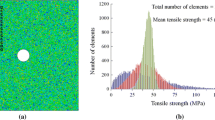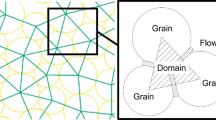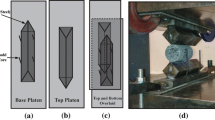Abstract
Hydraulic fracturing in permeable rock is a complicated process which might be influenced by various factors including the operational parameters (e.g., fluid viscosity, injection rate and borehole diameter) and the in situ conditions (e.g., in situ stress states and initial pore pressure level). To elucidate the effects of these variables, simulations are performed on hollow-squared samples at laboratory scale using fully coupled discrete element method. The model is first validated by comparing the stress around the borehole wall measured numerically with that calculated theoretically. Systematic parametric studies are then conducted. Modeling results reveal that the breakdown pressure and time to fracture stay constant when the viscosity is lower than 0.002 Pa s or higher than 0.2 Pa s but increases significantly when it is between 0.002 and 0.2 Pa s. Raising the injection rate can shorten the time to fracture but dramatically increase the breakdown pressure. Larger borehole diameter leads to the increase in the time to fracture and the reduction in the breakdown pressure. Higher in situ stress requires a longer injection time and higher breakdown pressure. The initial pore pressure, on the other hand, reduces the breakdown pressure as well as the time to fracture. The increase in breakdown pressure with viscosity or injection rate can be attributed to the size effect of greater tensile strength of samples with smaller infiltrated regions.

















Similar content being viewed by others
References
Adachi J, Siebrits E, Peirce A, Desroches J (2007) Computer simulation of hydraulic fractures. Int J Rock Mech Min 44:739–757
Al-Busaidi A, Hazzard J, Young R (2005) Distinct element modeling of hydraulically fractured Lac du Bonnet granite. J Geophys Res Solid Earth 1978–2012:110
Bohloli B, de Pater CJ (2006) Experimental study on hydraulic fracturing of soft rocks: influence of fluid rheology and confining stress. J Petrol Sci Eng 53:1–12
Bonilla-Sierra V, Scholtès L, Donzé FV, Elmouttie MK (2015) Rock slope stability analysis using photogrammetric data and DFN–DEM modelling. Acta Geotech 10:497–511
Cundall PA, Strack OD (1979) A discrete numerical model for granular assemblies. Geotechnique 29:47–65
Damjanac B, Detournay C, Cundall PA (2016) Application of particle and lattice codes to simulation of hydraulic fracturing. Comput Part Mech 3:249–261
Detournay E (2016) Mechanics of hydraulic fractures. Annu Rev Fluid Mech 48:311–339
Duan K, Kwok C (2016) Evolution of stress-induced borehole breakout in inherently anisotropic rock: insights from discrete element modeling. J Geophys Res Solid Earth 121:2361–2381
Duan K, Kwok CY, Ma X (2017) DEM simulations of sandstone under true triaxial compressive tests. Acta Geotech 12:495–510
Duan K, Kwok CY, Pierce M (2016) Discrete element method modeling of inherently anisotropic rocks under uniaxial compression loading. Int J Numer Anal Meth Geomech 40:1150–1183
Fatahi H, Hossain MM, Fallahzadeh SH, Mostofi M (2016) Numerical simulation for the determination of hydraulic fracture initiation and breakdown pressure using distinct element method. J Nat Gas Sci Eng 33:1219–1232
Gan Q, Elsworth D, Alpern JS, Marone C, Connolly P (2015) Breakdown pressures due to infiltration and exclusion in finite length boreholes. J Petrol Sci Eng 127:329–337
Goodfellow SD, Nasseri MHB, Maxwell SC, Young RP (2015) Hydraulic fracture energy budget: insights from the laboratory. Geophys Res Lett 42:3179–3187
Grassl P, Fahy C, Gallipoli D, Wheeler SJ (2015) On a 2D hydro-mechanical lattice approach for modelling hydraulic fracture. J Mech Phys Solids 75:104–118
Haimson B (1968) Hydraulic fracturing in porous and nonporous rock and its potential for determining in situ stresses at great depth. Minnesota University, Minneapolis
Haimson B (2007) Micromechanisms of borehole instability leading to breakouts in rocks. Int J Rock Mech Min 44:157–173
Haimson B, Fairhurst C (1967) Initiation and extension of hydraulic fractures in rocks. Soc Petrol Eng J 7:310–318
Haimson BC, Zhao Z (1991) Effect of borehole size and pressurization rate on hydraulic fracturing breakdown pressure. In: The 32nd US symposium on rock mechanics (USRMS). American Rock Mechanics Association
Hazzard JF, Young RP, Maxwell SC (2000) Micromechanical modeling of cracking and failure in brittle rocks. J Geophys Res Solid Earth 105:16683–16697
Hubbert MK, Willis DG (1957) Mechanics of hydraulic fracturing. US Geol Surv 210:153–168
Itasca (2008) PFC2D particle flow code in 2 dimensions, 4.0th edn. Itasca, Minneapolis
Labra C, Rojek J, Oñate E, Zarate F (2008) Advances in discrete element modelling of underground excavations. Acta Geotech 3:317–322
Li L, Meng Q, Wang S, Li G, Tang C (2013) A numerical investigation of the hydraulic fracturing behaviour of conglomerate in Glutenite formation. Acta Geotech 8:597–618
Newman Jr J (1971) An improved method of collocation for the stress analysis of cracked plates with various shaped boundaries. NASA Tech. Note D-6373. Langley Research Center, Hampton
Potyondy DO (2015) The bonded-particle model as a tool for rock mechanics research and application: current trends and future directions. Geosyst Eng 18:1–28
Potyondy DO, Cundall PA (2004) A bonded-particle model for rock. Int J Rock Mech Min 41:1329–1364
Pruess K (2006) Enhanced geothermal systems (EGS) using CO2 as working fluid—a novel approach for generating renewable energy with simultaneous sequestration of carbon. Geothermics 35:351–367
Shimizu H, Murata S, Ishida T (2011) The distinct element analysis for hydraulic fracturing in hard rock considering fluid viscosity and particle size distribution. Int J Rock Mech Min 48:712–727
Tomac I, Gutierrez M (2015) Formulation and implementation of coupled forced heat convection and heat conduction in DEM. Acta Geotech 10:421–433
Tomac I, Gutierrez M (2017) Coupled hydro-thermo-mechanical modeling of hydraulic fracturing in quasi-brittle rocks using BPM-DEM. J Rock Mech Geotech Eng 9:92–104
Warpinski NR, Mayerhofer MJ, Vincent MC, Cipolla CL, Lolon E (2009) Stimulating unconventional reservoirs: maximizing network growth while optimizing fracture conductivity. J Can Pet Technol 48:39–51
Wu W, Zoback MD, Kohli AH (2017) The impacts of effective stress and CO2 sorption on the matrix permeability of shale reservoir rocks. Fuel 203:179–186
Zhang X, Jeffrey RG, Thiercelin M (2009) Mechanics of fluid-driven fracture growth in naturally fractured reservoirs with simple network geometries. J Geophys Res Solid Earth 114:B12406
Zhang X, Lu Y, Tang J, Zhou Z, Liao Y (2017) Experimental study on fracture initiation and propagation in shale using supercritical carbon dioxide fracturing. Fuel 190:370–378
Zhao X, Young P (2011) Numerical modeling of seismicity induced by fluid injection in naturally fractured reservoirs. Geophysics 76:WC167–WC180
Zhou J, Jin Y, Chen M (2010) Experimental investigation of hydraulic fracturing in random naturally fractured blocks. Int J Rock Mech Min 47:1193–1199
Zoback MD, Moos D, Mastin L, Anderson RN (1985) Well bore breakouts and in situ stress. J Geophys Res Solid Earth 1978–2012(90):5523–5530
Zoback MD, Rummel F, Jung R, Raleigh CB (1977) Laboratory hydraulic fracturing experiments in intact and pre-fractured rock. Int J Rock Mech Min Sci Geomech Abstr 14:49–58
Acknowledgements
The authors would like to appreciate the two anonymous reviewers for their constructive comments.
Author information
Authors and Affiliations
Corresponding authors
Rights and permissions
About this article
Cite this article
Duan, K., Kwok, C., Wu, W. et al. DEM modeling of hydraulic fracturing in permeable rock: influence of viscosity, injection rate and in situ states. Acta Geotech. 13, 1187–1202 (2018). https://doi.org/10.1007/s11440-018-0627-8
Received:
Accepted:
Published:
Issue Date:
DOI: https://doi.org/10.1007/s11440-018-0627-8




